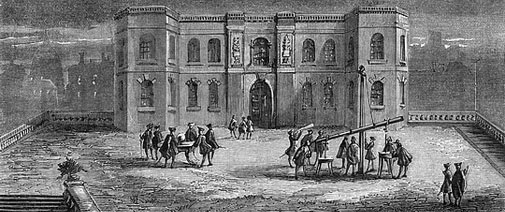Ole Rømer and the retardation of light
In the spring of 1672 Ole Rømer travelled with Jean Picard to Paris. For the next nine he was working with observations at the new royal observatory, The Paris Observatory. He was also engaged by Louis XIV to teach the Dauphin and he assisted with the plans for the water supply and fountain systems at Versailles and the Châteu de Marly. It was in this period that he made his discovery about the finite speed of light.

The observatory in Paris was founded in 1667. The picture here shows how it looked in Ole Rømer’s time.
The moons of Jupiter
Galileo Galilei had discovered four moons around Jupiter in 1610. Ole Rømer had already learned about them during his work determining the position of Uranienborg on Hven. While the latitude was easy to determine, it required ingenuity to find the correct longitude. Jean Picard used a method where he took the moons of Jupiter passed its shadow and compared the two times on Hven and in Paris. In Paris, Ole Rømer continued to observe the moon Io’s movement around Jupiter. These observations were not only important because of their astronomical significance, but also because they could provide methods and tables for determining longitudes at sea and on land.

Illustration from the article on the speed of light published by Ole Rømer in 1676. Ole Rømer compared the length of Io’s orbital period, as the Earth was moving towards Jupiter (F to G) and away from Jupiter (L to K).
The retardation of light
Over a year, Ole Rømer noted the points in time when Io could again be seen after having passed behind Jupiter. Because Io’s orbital period is 42.5 hours, there should always be precisely 42.5 hours between each appearance if light diffuses with infinite speed. But Ole Rømer discovered that there were many irregularities in Io’s orbital period: Some times Io appeared too early and other times too late in relation to the expected times. The irregularities repeated themselves precisely at a one-year interval, which meant that they must be connected to the Earth’s rotation around the Sun.
The head of the observatory in Paris, Giovanni Cassini, had also noticed the irregularities. In 1675 he wrote that "The second difference seems to reflect that the light takes time to reach us from the satellite; the light appears to take around ten to eleven minutes to traverse a distance of half of the Earth’s rotational diameter.” Oddly enough, Giovanni Cassini abandoned this theory, while Ole Rømer took it to heart and soon he was able to produce convincing observations to support it. He found that it takes light 22 minutes to traverse the Earth’s orbital diameter; the correct figure was later determined to be 16 minutes and 40 seconds.
|
|


